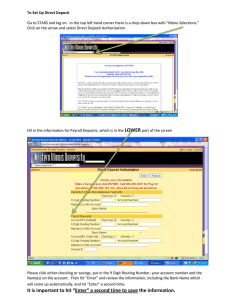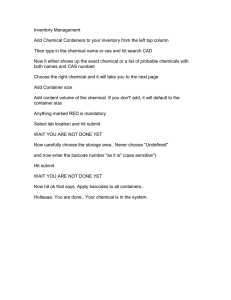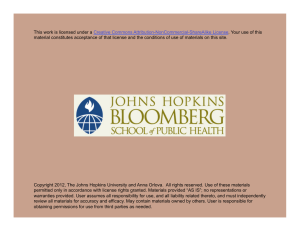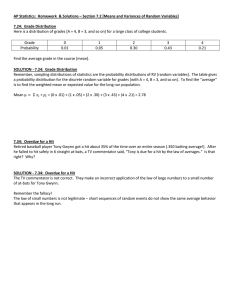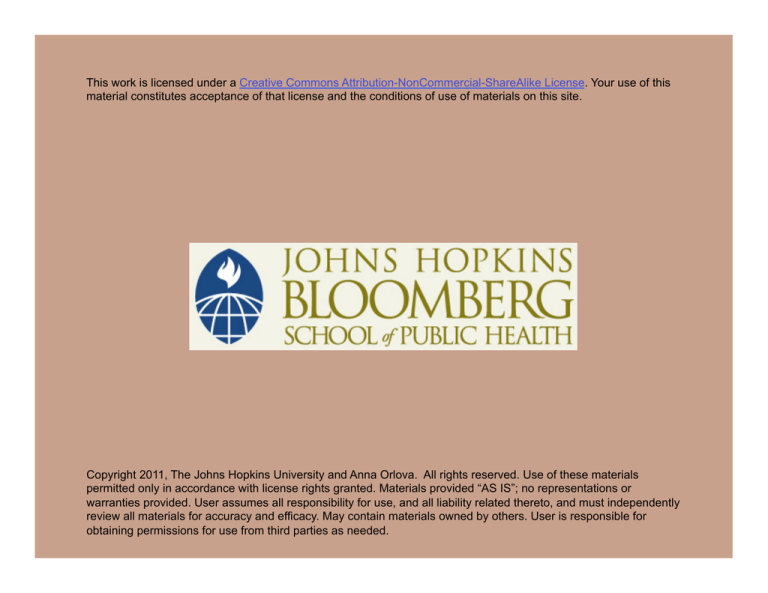
This work is licensed under a Creative Commons Attribution-NonCommercial-ShareAlike License. Your use of this
material constitutes acceptance of that license and the conditions of use of materials on this site.
Copyright 2011, The Johns Hopkins University and Anna Orlova. All rights reserved. Use of these materials
permitted only in accordance with license rights granted. Materials provided “AS IS”; no representations or
warranties provided. User assumes all responsibility for use, and all liability related thereto, and must independently
review all materials for accuracy and efficacy. May contain materials owned by others. User is responsible for
obtaining permissions for use from third parties as needed.
Section E
Role of Public Health in HIT Standardization
Business Case: Public Health in HIT Standardization
URL: http://www.phdsc.org/standards/business_case.asp
3
Business Case: Public Health in HIT Standardization
National HIT standardization process requires collective input from
public health regarding which public health issues need to be
addressed in national interoperable HIT standards
- This input needs to be collaboratively developed, put through
the national HIT standardization process, and uniformly
implemented
Public Health’s “Organized Voice on HIT Standards” will have to
take on a character reflective of this reality
URL: http://www.phdsc.org/standards/pdfs/PHDSC_Business_Case_Public_Health_HIT-Standardization.pdf
4
Business Case: Public Health in HIT Standardization
We define Public Health’s Organized Voice on HIT Standards as an
open, transparent, participatory process of harmonizing programspecific and jurisdictional needs with national HIT interoperability
standards by working with public health stakeholders and HIT
standardization entities on various phases of HIT standardization
URL: http://www.phdsc.org/standards/pdfs/PHDSC_Business_Case_Public_Health_HIT-Standardization.pdf
5
PHDSC Business Case
HIT standardization phases
Goals
Public health
programs
undergoing
HIT standardization
Standards
documents
Needs and
priorities
• AHIC/MU:
• biosurveillance
• Immunization
• ELR
• Public health
reporting
• Newborn
screening
• Vital records
Use cases
(description of
the health
information
exchanges)
On-going activities ( 2008-now)
New activities (2010-11)
Future activities
Development and
maintenance
Selection and
Harmonization
Testing/trial
implementation
Certification
• Biosurveillance
• Immunization
• ELR
• Biosurveillance
• Immunization
• ELR
• Public health
reporting
• Public health
reporting
• Newborn
screening
• Vital records
• Hearing
• Vital records
• Hearing
• Vital records
• Hearing
• Vital records
• Cancer
• Cancer
• Cancer
• Cancer
PHDSC projects
Interoperability
specifications
Standards
Technical
frameworks
Integration
profiles
Deployment
Functional
profiles
Test reports
Certification
criteria
Deployment
reports
Developed methodology for public health participation in HIT standards development
and harmonization
Develop methodology for public health participation in HIT product testing and
certification
Develop methodology for evaluation of standard-based HIT products
(HIT adoption)
6
PHDSC Business Case
HIT standardization phases
Goals
Public health
programs
undergoing
HIT standardization
Needs and
priorities
What should be
accomplished?
• AHIC/MU:
• biosurveillance
• Immunization
• ELR
• Public health
reporting
• Newborn
screening
• Vital records
Development and
maintenance
Selection and
Harmonization
Testing/trial
implementation
What are the
standards?
What
standards
to use?
Show what
can be
accomplished
Certification
Deployment
Certify
standardsbased
products
• Biosurveillance
• Immunization
• ELR
• Biosurveillance
• Immunization
• ELR
• Public health
reporting
• Public health
reporting
• Newborn
screening
• Vital records
• Hearing
• Vital records
• Hearing
• Vital records
• Hearing
• Vital records
• Cancer
• Cancer
• Cancer
• Cancer
Deploy
standardsbased
products
PHDSC projects
?
ONC standards
and
interoperability
framework
7
Standardization Phases
Deployment of standards-based products
Deploy standards-based IT products
8
Standard Deployment
US
9
Business Case: Public Health in HIT Standardization
Adapted by CTLT from PHDSC. Business Case: The Role of Public Health in National Health Information
Technology Standardization. Baltimore, MD, 2009.
10
Assuring Health IT Standards for Public Health
Implementing the business case through:
- Develop and implement a methodology for public health
participation in HIT standardization efforts—PHDSC action plan
towards public health sector transformation and sector unity
- Educate public health community about health informatics and
HIT standards
11
HIT Standards
Resources
Gordon Bell. A Time and Place for
Standards.
http://acmqueue.com/
modules.php?
name=Content&pa=showpage&pid
=210
Health IT Standards Committee (a
federal advisory committee).
http://healthit.hhs.gov/portal/
server.pt?
open=512&objID=1271&parentnam
e=CommunityPage&parentid=6&m
ode=2
Public Health Data Standards
Consortium (PHDSC). Health
Information Technology
Standards.
http://www.phdsc.org/standards/
health-information-techstandards.asp
Public Health Data Standards
Consortium (PHDSC). (2009).
Business Case: Role of Public
Health In National Health
Information Technology
Standardization.
http://www.phdsc.org/standards/
pdfs/
PHDSC_Business_Case_Public_Heal
th_HIT-Standardization.pdf
13
Coming up Next …
Coming up Next …

